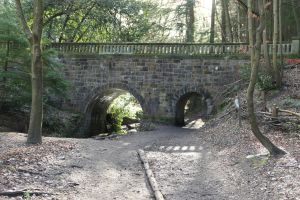Gilderland Bridge: Difference between revisions
Created page with "{| class="wikitable" style="float:right; width:320px; margin-left:10px;" ! colspan="2" | Building summary |- | colspan="2" style="text-align: center;" | [photo awaited] |- | s..." |
No edit summary |
||
| (9 intermediate revisions by the same user not shown) | |||
| Line 2: | Line 2: | ||
! colspan="2" | Building summary | ! colspan="2" | Building summary | ||
|- | |- | ||
| colspan="2" style="text-align: center;" | [ | | colspan="2" style="text-align: center;" | [[File:Gilderland Bridge.JPG|300px]] | ||
|- | |- | ||
| style="width:50%"| '''Name''' || Gilderland Bridge | | style="width:50%"| '''Name''' || Gilderland Bridge | ||
| Line 12: | Line 12: | ||
| '''Other names''' || | | '''Other names''' || | ||
|- | |- | ||
| '''Date''' || | | '''Date''' || c.1874 | ||
|- | |- | ||
| '''Architect''' || | | '''Architect''' || William Burn | ||
|- | |- | ||
| '''OS grid ref''' || | | '''OS grid ref''' || NO 24193 07437 | ||
|- | |- | ||
| '''Latitude & longitude''' || 56°15′12″N 3°13′30″W | | '''Latitude & longitude''' || 56°15′12″N 3°13′30″W | ||
|} | |} | ||
__NOTOC__ | __NOTOC__ | ||
'''[[ | '''The Gilderland Bridge''' crosses the [[Maspie Burn]], and also a footpath, near the [[House of Falkland]]. Gilderland is another name for Guelders, and presumably commemorates Queen Mary of Guelders, wife of King James II of Scotland. | ||
{| class=wikitable | {| class=wikitable | ||
!HES listing details<ref>[http://portal.historicenvironment.scot/designation/ | ! colspan=3 | HES listing details<ref>[http://portal.historicenvironment.scot/designation/LB8765 HES record for LB8765]</ref> | ||
|- | |||
| '''Reference:''' LB8765 | |||
| '''Date:''' 01/02/1972 | |||
| '''Category:''' B | |||
|- | |- | ||
| '''Address/Site Name''' | | colspan=3 | '''Address/Site Name''' | ||
House of Falkland | House of Falkland Estate, Gilderland Bridge over Maspie Burn | ||
|- | |- | ||
| '''Description''' | | colspan=3 | '''Description''' | ||
William Burn, circa 1844. Tall, round-arched bridge with smaller round-arched pedestrian arch to E on slightly curved plan. Squared and snecked rubble with rusticated voussiors; corniced stone ashlar parapet with continuous arcaded balustrade; square-plan, coped terminal piers. | |||
|- | |- | ||
|'''Statement of special interest''' | | colspan=3 | '''Statement of special interest''' | ||
This tall road bridge, built by William Burn, is an important part of the designed landscape surrounding the House of Falkland. The bridge includes a particularly good parapet, which is composed of a continuous arcade of arches set on a curved plan. [...] | |||
|} | |} | ||
==Notes== | ==Notes== | ||
<references /> | <references /> | ||
[[Category:Category B listed buildings]] | [[Category:Category B listed buildings]] | ||
[[Category: | [[Category:House of Falkland and designed landscape]] | ||
[[Category: | [[Category:Bridges]] | ||
Latest revision as of 05:36, 3 April 2021
| Building summary | |
|---|---|

| |
| Name | Gilderland Bridge |
| Address | |
| Postcode | |
| Other names | |
| Date | c.1874 |
| Architect | William Burn |
| OS grid ref | NO 24193 07437 |
| Latitude & longitude | 56°15′12″N 3°13′30″W |
The Gilderland Bridge crosses the Maspie Burn, and also a footpath, near the House of Falkland. Gilderland is another name for Guelders, and presumably commemorates Queen Mary of Guelders, wife of King James II of Scotland.
| HES listing details[1] | ||
|---|---|---|
| Reference: LB8765 | Date: 01/02/1972 | Category: B |
| Address/Site Name
House of Falkland Estate, Gilderland Bridge over Maspie Burn | ||
| Description
William Burn, circa 1844. Tall, round-arched bridge with smaller round-arched pedestrian arch to E on slightly curved plan. Squared and snecked rubble with rusticated voussiors; corniced stone ashlar parapet with continuous arcaded balustrade; square-plan, coped terminal piers. | ||
| Statement of special interest
This tall road bridge, built by William Burn, is an important part of the designed landscape surrounding the House of Falkland. The bridge includes a particularly good parapet, which is composed of a continuous arcade of arches set on a curved plan. [...] | ||